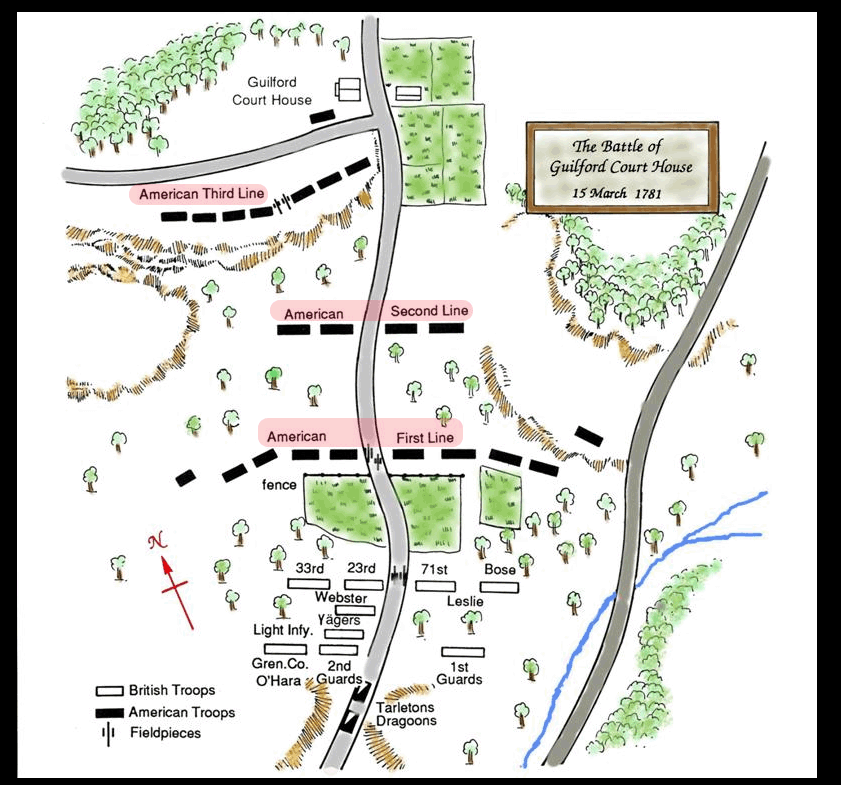The Battle of Guilford Courthouse in North Carolina took place on March 15, 1781. American forces, numbering 4,400 to 4,500 Continental troops and militia, were lead by Major General Nathaniel Green.
Green had prepared his defense in three lines, as shown in red on the map below. The first line was the North Carolina militia, with backwoods riflemen on the left and right flanks to snipe advancing British. They were equipped with some cannons. John Ludwick Albright (#111) served as a private in the militia. He was attached to Trousdale's Company with Hugh Tinnen acting as Colonel.
The second line was the Virginia militia with two six-pound cannons sited in the center of the line. According to the U.S. Pension Roll of 1835, Daniel Donnell (#105) was a private in the Virginia militia.
The third line was the Virginian Regiment, Delaware infantry, and the 1st and 2nd Maryland regiments 400 yards further. The three lines were hundreds of yards apart and could not support one another.[Note: Part of the Virginian Regiment were the Light Dragoons. William Love (#115) was a member of that regiment.]
The map below shows the Guilford Court House Battleground, based on c. 2006 National Park Service Map.
British troops, numbering 1,900 Soldiers, were lead by Lieutenant General Charles Cornwallis. After ~ 2 hours, Greene ordered his troops to retreat, saving a lot of lives. Although their retreat gave the British a tactical victory, more than 25% of the British troops had been killed, wounded or captured in the battle.
The Battle of Guilford Courthouse was actually a strategic victory for the Continental troops and a turning point in the Revolutionary War because after this battle, and after losing so many men, Cornwallis abandoned his campaign in the Carolinas and took his army into Virginia.
In October of 1781 following the Battle of Yorktown, Cornwallis was forced to surrender to General George Washington and French commander Jean-Baptiste-Donathien de Vimeur, Comte de Rochambeau.
The war ended in 1783 with the Treaty of Paris. By signing that treaty, Great Britain recognized the United States as an independent nation.
Casualities at the Battle of Guilford Court House
Continental Troops
57 killed
111 wounded
161 missingMilitia
22 killed
74 wounded
885 missing
Total:
79 killed
185 wounded
1,046 missing
British Troops
91 Killed
408 Wounded
25 Missing
The Battle of Guilford Courthouse took place near the present-day city of Greensboro, named for General Greene.
Interestingly, Forest Lawn Cemetery (site of the burials of Terry Donnell Sharpe #7 (1881-1957) and his wife Mary Gertrude Colerider (#8) (1886 -1962)) is located in the area still known as Guilford Battleground. Terry Donnell Sharpe is the Great, Great Grandson of both John Ludwick Albright (#111) (1761-1816) and Daniel Donnell #105) (1755-1835) who fought on that battleground. Mary Gertrude Colerider is the Great Great Granddaughter of another patriot who fought there, William Love (#115).
[Note: References: Pension Application by Elizabeth Albright for her deceased husband Ludwick Albright, National Archives Microseries M804, Roll 24, #W5609, 1840; U.S. Revolutionary Pension Roll of 1835 for Daniel Donnell; Pension Application of Robert Love 1851 and John Love 1855).]
Contact person for this website is Susan Snyder: susanleachsnyder@gmail.com

